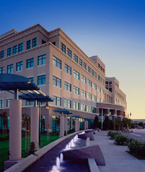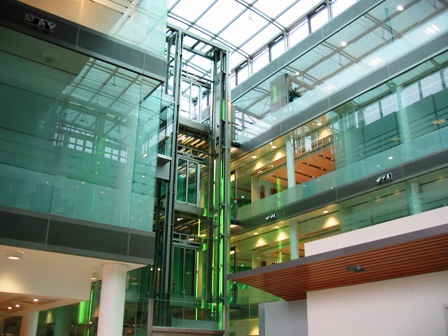POSTS
American Aesthetics, European Splendour
BlogMy father and I have had a number of discussions about architecture in Europe versus architecture in the Empire. Here in the Empire our office buildings are downright ugly – even the buildings where the honchos are, the buildings are pretty blase. Yet the same corporation’s building in another country - especially Europe is usually quite impressive.
Take for example the Silicon Valley’s office parks or buildings (Intel, Nortel, NVidia, Juniper, Yahoo, AMD). The Ciscoland campus is basically a putty and teal series of boxes: buildings A-O, Buildings 1-22. The standout building, the one with the circular drive and 1 more floor than all the rest with the flagpoles is the executive building. Here it is:

As you can see, it’s nice…enough. The real standout feature is the beautiful Northern California sunrise which is even pretty good from my hole in the wall in Mountain View.
Now the UK building is a real symphony of glass and steel. Check this thing out:
Photo courtesy of: Living in London
Nice, huh?
Likewise the Australian office is one of the big towers that, in the Asian tradition, has a huge liteboard display of the company logo. I hear the Japanese office is something out of “2001” etc.
As I said, my father and I have discussed this point quite a lot, he had experienced the same when working for the Oil and Gas Megalith he used to work for. He said that it boiled down to looking at the numbers, it was hard to justify to Senior management (who appealed to the fiduciary responsibility to the shareholders) that they chose to spend extra on a beautiful building versus simply a building where the work could get done. We chalked this up to the Puritain Work Ethic / Over-obsessive focus on the bottom line such that comfort and beauty are ’needless extras'.
Based on this I suggested that: It’s all the same company, so the American shareholder would punish the American worker and demand they work away in nondescript , uninspired, uninspiring buildings while that same American shareholder was happy for the company to build beautiful buildings in other countries for foreign workers?
For me this discussion came down to a quote found in a Salon article which cited how Tony Judt differentiated European American production values:
“Consider a mug of American coffee,” he wrote. “It is found everywhere. It can be made by anyone. It is cheap – and refills are free. Being largely without flavor, it can be diluted to taste. What it lacks in allure it makes up in size. It is the most democratic method ever devised for introducing caffeine into human beings. Now, take a cup of Italian espresso. It requires expensive equipment. Price-to-volume ratio is outrageous, suggesting indifference to the consumer and ignorance of the market. The aesthetic satisfaction accessory to the beverage far outweighs its metabolic impact. It is not a drink; it is an artifact.”
I was interested in what a little bit of Perl would do to this statement. Perl, as a programming language, is very good at search and replace functions. For the non-speaker, suffice it to say that this construct: s,something,else,gi is the speaker’s way of saying “Replace something with else everywhere where something is found (i.e. globally, thus “g” at the end), indifferent to case (indifferently, thus “i” at the end).
So here was my first thought, cut and pasted from code:
# We are no longer talking about coffee, but architecture.
s,a\s+\w+\s+\w+\w+\s+(\w+)\s+\w+,an $1 office building,gi;
s,(beverage|drink),building,gi;
Line one turns a (container) of (nationality) (coffee-beverage) into “an (that nationality) office building”
Line two turns “beverage or drink” into “building”.
In the next part of the program we do:
# In this quote the functional purpose is coffee is to
# deliver caffiene, the functional purpose of an office
# building is to provide a workspace for humans
s,caffeine,human,;
s,metabolic impact,functional value,,;
s,human\s+beings,workspaces,gi;
The # entries (called comments) should make pretty clear what goes on in that bracket.
I needed to add a command to print out the altered code.
Thus, fully assembled, the code looks like:
#!/usr/local/bin/perl
while (<STDIN>){
# We are no longer talking about coffee, but architecture.
s,a\s+\w+\s+\w+\w+\s+(\w+)\s+\w+,an $1 office building,gi;
s,(beverage|drink),building,gi;
# In this quote the functional purpose is coffee is to
# deliver caffiene, the functional purpose of an office
# building is to provide a workspace for humans
s,caffeine,human,;
s,metabolic impact,functional value,,;
s,human\s+beings,workspaces,gi;
print $_;
}
And the output, is actually quite sensible:
“Consider an American office building,” he wrote. “It is found everywhere. It can be made by anyone. It is cheap – and refills are free. Being largely without flavor, it can be diluted to taste. What it lacks in allure it makes up in size. It is the most democratic method ever devised for introducing human into workspaces. Now, take an Italian office building. It requires expensive equipment. Price-to-volume ratio is outrageous, suggesting indifference to the consumer and ignorance of the market. The aesthetic satisfaction accessory to the building far outweighs its functional value. It is not a building; it is an artifact.”
